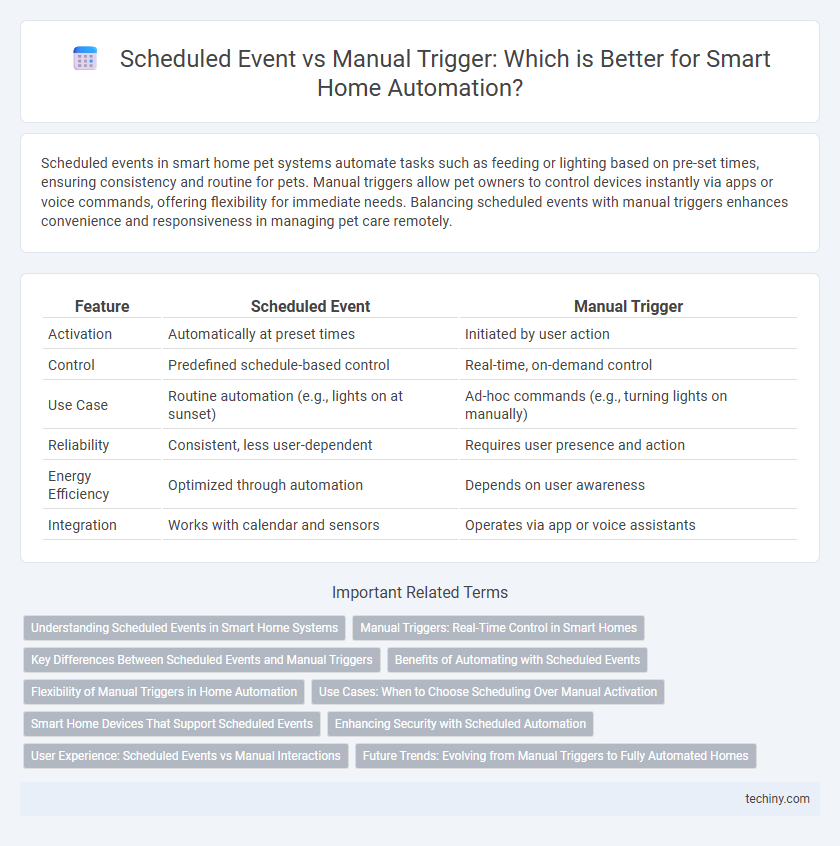Scheduled events in smart home pet systems automate tasks such as feeding or lighting based on pre-set times, ensuring consistency and routine for pets. Manual triggers allow pet owners to control devices instantly via apps or voice commands, offering flexibility for immediate needs. Balancing scheduled events with manual triggers enhances convenience and responsiveness in managing pet care remotely.
Table of Comparison
| Feature | Scheduled Event | Manual Trigger |
|---|---|---|
| Activation | Automatically at preset times | Initiated by user action |
| Control | Predefined schedule-based control | Real-time, on-demand control |
| Use Case | Routine automation (e.g., lights on at sunset) | Ad-hoc commands (e.g., turning lights on manually) |
| Reliability | Consistent, less user-dependent | Requires user presence and action |
| Energy Efficiency | Optimized through automation | Depends on user awareness |
| Integration | Works with calendar and sensors | Operates via app or voice assistants |
Understanding Scheduled Events in Smart Home Systems
Scheduled events in smart home systems automate device actions based on predefined times, enhancing convenience and energy efficiency by eliminating the need for manual intervention. These events utilize built-in timers or calendars to trigger activities such as lighting adjustments, thermostat changes, or security system activations. Understanding scheduled events helps users optimize system performance and create consistent routines tailored to daily habits and preferences.
Manual Triggers: Real-Time Control in Smart Homes
Manual triggers in smart homes provide real-time control by allowing users to instantly activate devices and adjust settings without waiting for pre-programmed schedules. This immediate responsiveness enhances convenience and customization, enabling precise management of lighting, security systems, and climate controls based on current needs. By bypassing scheduled events, manual triggers optimize energy efficiency and user comfort through dynamic interaction with smart home technology.
Key Differences Between Scheduled Events and Manual Triggers
Scheduled events in smart home systems automatically activate devices based on preset times or conditions, ensuring consistent and hands-free control of lighting, heating, and security. Manual triggers require user intervention, allowing for immediate and flexible activation of devices via apps, voice commands, or physical switches. The key differences lie in automation level, user dependency, and the ability to respond dynamically versus following a fixed schedule.
Benefits of Automating with Scheduled Events
Automating smart home devices with scheduled events ensures consistent energy savings by running appliances only when needed, such as adjusting thermostats at specific times to optimize heating and cooling efficiency. Scheduled events enhance security by automatically activating lights and alarms during preset hours, reducing the risk of human error compared to manual triggers. This automation increases convenience and reliability, enabling seamless control over systems without requiring constant user intervention.
Flexibility of Manual Triggers in Home Automation
Manual triggers in home automation offer unmatched flexibility by allowing users to activate devices or scenes on demand without relying on pre-set schedules. Unlike scheduled events, which operate on fixed timers, manual triggers enable immediate response to changing conditions or user preferences, enhancing convenience and personalized control. This dynamic interaction supports real-time adjustments, making smart homes more adaptable to spontaneous needs and lifestyle variations.
Use Cases: When to Choose Scheduling Over Manual Activation
Scheduled events in smart home systems ensure consistent automation for daily routines like lighting, heating, and security, optimizing energy use and convenience without user intervention. Manual triggers allow immediate control for unexpected situations or one-time adjustments, such as turning on lights when entering a room at night. Scheduling is preferred for repetitive, predictable actions, while manual activation suits spontaneous or irregular needs.
Smart Home Devices That Support Scheduled Events
Smart home devices that support scheduled events enable automated control based on predefined times, enhancing convenience and energy efficiency. Unlike manual triggers, which require user intervention, scheduled events operate autonomously, allowing operations such as thermostat adjustments, lighting changes, and security system activations to occur without direct input. Popular devices with this feature include smart thermostats like Nest, automated lighting systems like Philips Hue, and smart plugs from TP-Link, all designed to streamline home management through precise timing controls.
Enhancing Security with Scheduled Automation
Scheduled events in smart home systems enhance security by automating routine actions such as locking doors and activating alarms at specific times, reducing human error and ensuring consistent protection. Manual triggers offer flexibility for immediate responses but depend on user presence and awareness, which can create vulnerabilities during unexpected situations. Integrating scheduled automation with manual overrides provides a balanced security approach, optimizing both reliability and responsiveness.
User Experience: Scheduled Events vs Manual Interactions
Scheduled events in smart homes enhance user convenience by automating routines such as lighting, heating, and security, reducing the need for constant manual input and ensuring consistent operation even when users are away. Manual triggers offer instant control, allowing users to override automated settings and adjust devices based on immediate needs, promoting flexibility and personalization. Balancing scheduled automation with manual interactions creates a seamless user experience by combining reliability with adaptability in smart home management.
Future Trends: Evolving from Manual Triggers to Fully Automated Homes
Scheduled events enable smart homes to perform tasks automatically based on predefined times, enhancing convenience and energy efficiency. Manual triggers, while offering direct user control, are gradually being supplemented by AI-driven automation that anticipates user needs without explicit commands. Future trends focus on integrating predictive analytics and machine learning to transition from manual interventions to fully autonomous home environments that optimize comfort, security, and resource management.
Scheduled Event vs Manual Trigger Infographic

 techiny.com
techiny.com